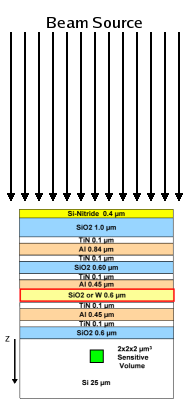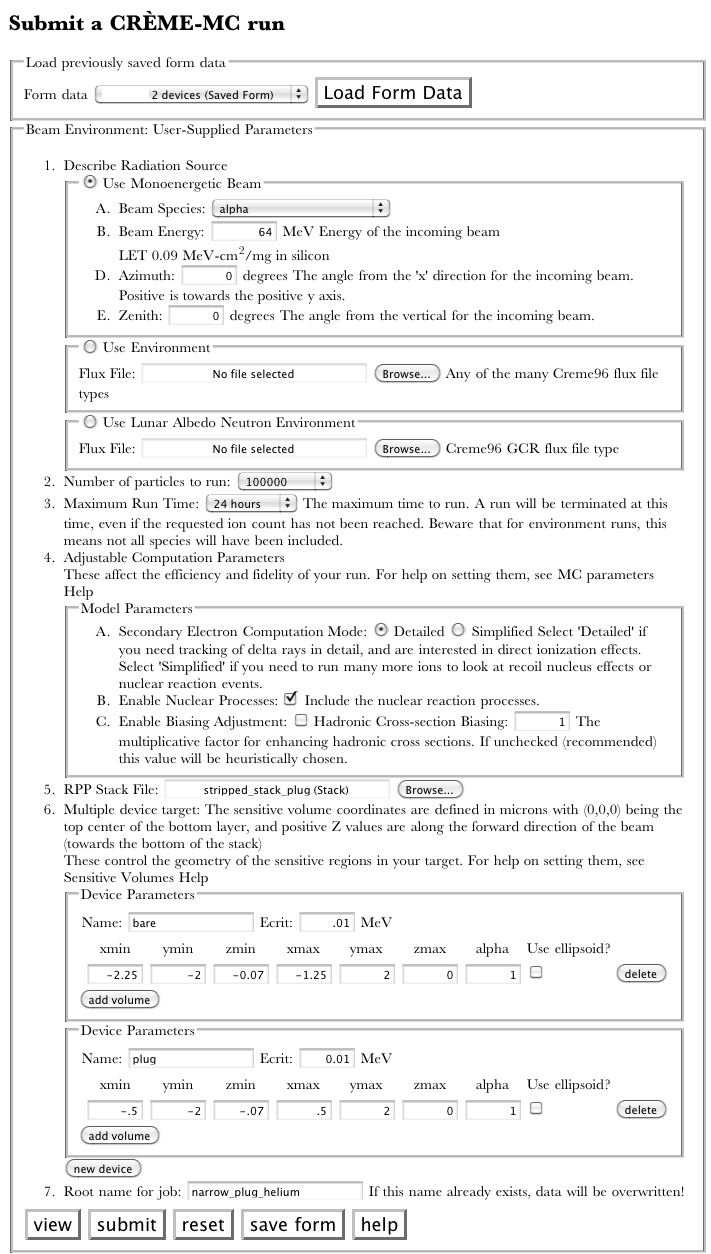Submitting a Beam Job
Overview
The approach pursed in CRÈME-MC is to create a physical model for charge collection. Under the IRPP model, a phenomenological model, the results of accelerated tests are used as input to the routine typically in the form of a Weibull curve. It is therefore important to calibrate and assess the fidelity of the CRÈME-MC sensitive volume model under broadbeam conditions.
The user may define the beam with a combination of ion species and energy. All ion species from Z=1 to 92 are provided as well as electrons. For the selected particle, the linear energy transfer (LET) value is estimated and presented to the user.
The angle of irradiation is defined according to azimuth and zenith with (0o AZ,0o ZE) representing normal incidence. The zenith controls the angle from the vertical of the incoming beam. The azimuth controls the angle from the x direction for the incoming beam where positive values move toward the positive y axis.
The user must also select the number of particles to simulate. This value will be driven by the level of statistics needed and the size of the target. For the same number of particles, a larger stack reduces the beam fluence.
When the simulation is complete, a report is automatically generated. In addition to the input parameters, the report contains the result of the simulation. The unprocessed output of a single device model is a histogram of event weights versus energy. A second plot is generated from the histogram by dividing by the beam fluence to obtain the event cross section.
For a user imposed threshold, the single event cross section can be obtained for a device. When a multiple device model with event thresholds has been specified, a table of multiplicity and event cross section is also supplied. Both the plots and table contain error bars from counting statistics.
This module performs a monte carlo simulation of a mono-energetic normally incident particle beam on a stack structure and sensitive volume. The beam is oriented in the positive Z direction and is guaranteed to be randomly distributed over the surface of the stack structure. The simulation can be used to examine the effects that various overlayer materials have on the energy deposition within a sensitive volume.

Inputs
To run the module, you must:
- Choose a particle species
- Choose the particle energy in MeV
- Select the number of particles to simulate. A larger number of particles simulated in a monte carlo calculation provides better statistics of infrequent occurrences but will increase run time accordingly.
- Select an RPP stack structure. This file contains information about the composition of materials that exist in the vicinity of a sensitive volume.
- Provide the min and max corners of the sensitive volume. The coordinates are defined with (0,0,0) being the top center of the bottom layer provided by the RPP stack structure, and positive Z values are along the forward direction of the beam. Sensitive volumes are specified in the Multiple Device Target section. Here you may specify the placement and critical energy of more than one device.

Output
The module will submit a simulation job. Once the job has completed, a report will be generated. This report will document the physical processes included in the simulation, beam parameters, a description of the target and sensitive volume placement, followed by the results of the simulation. Within the Calorimetry section, one is presented with a histogram of energy deposited within the device(s). This is followed by a table of the total energy deposited in each device, ie. the energy obtained through integrating the respective histogram. Note that these are both raw values that are dependent on the number of particles sampled. In the following section, the device cross section is obtained by reverse integrating the counts of energy deposition events divided by the fluence. If multiple devices have been specified, the plot will contain multiple histograms. If multiple devices overlap in space, the energy deposited in the overlap will be counted toward both devices. Depending on the study, this may not be desirable. The multiple device simulation also tracks the number of times a single event deposits more than the critical energy in two or more devices. This is reported as a cross section for multiple device upset.




